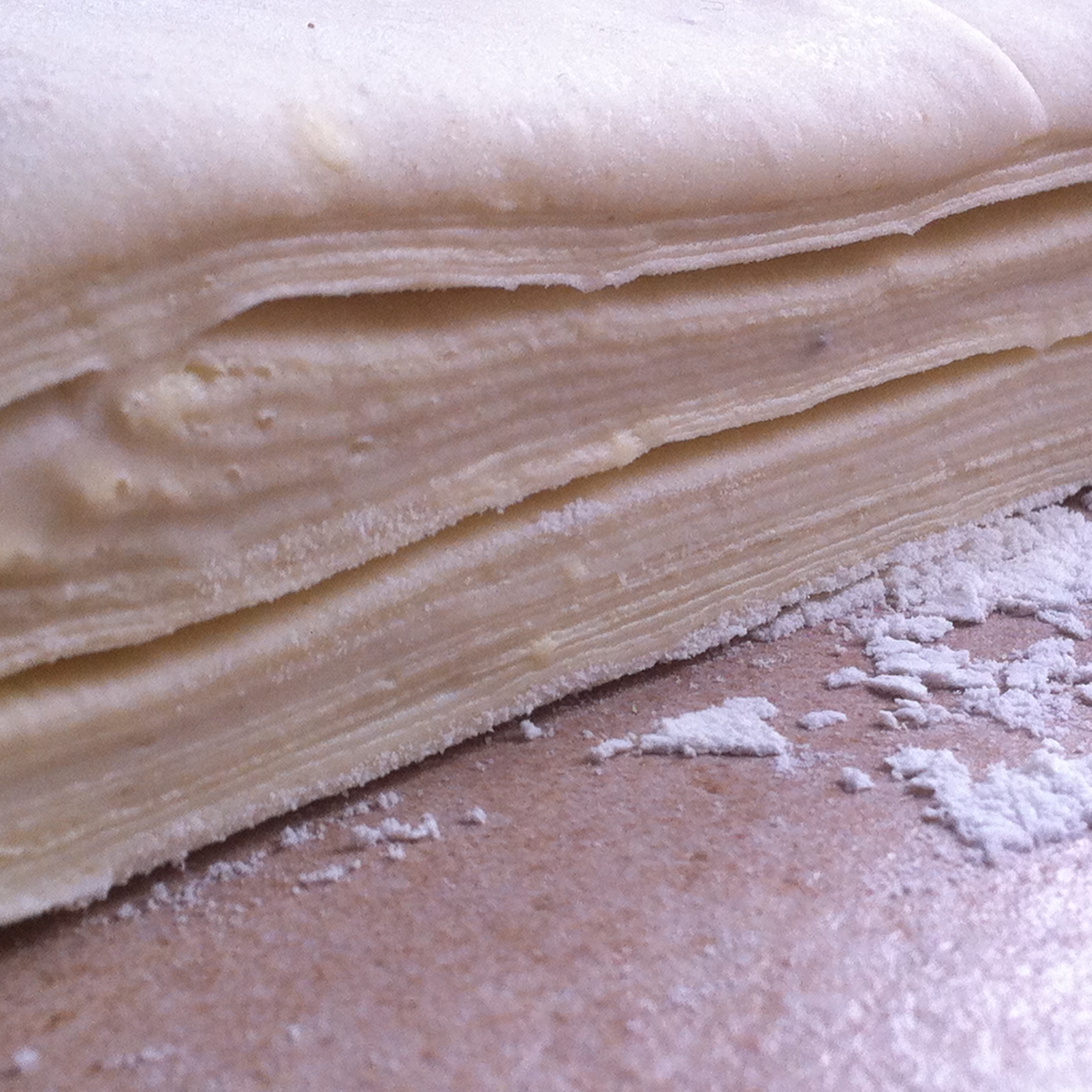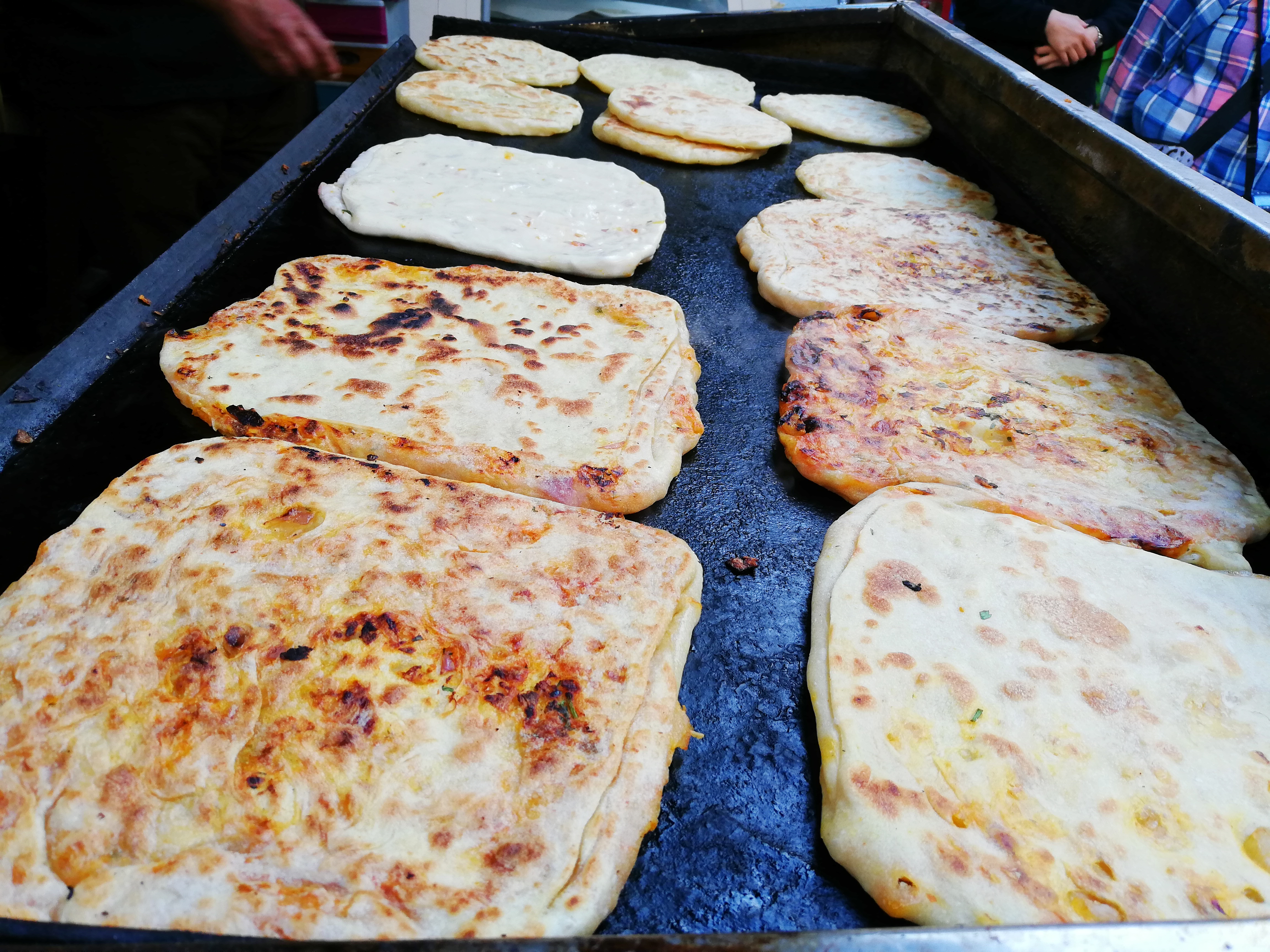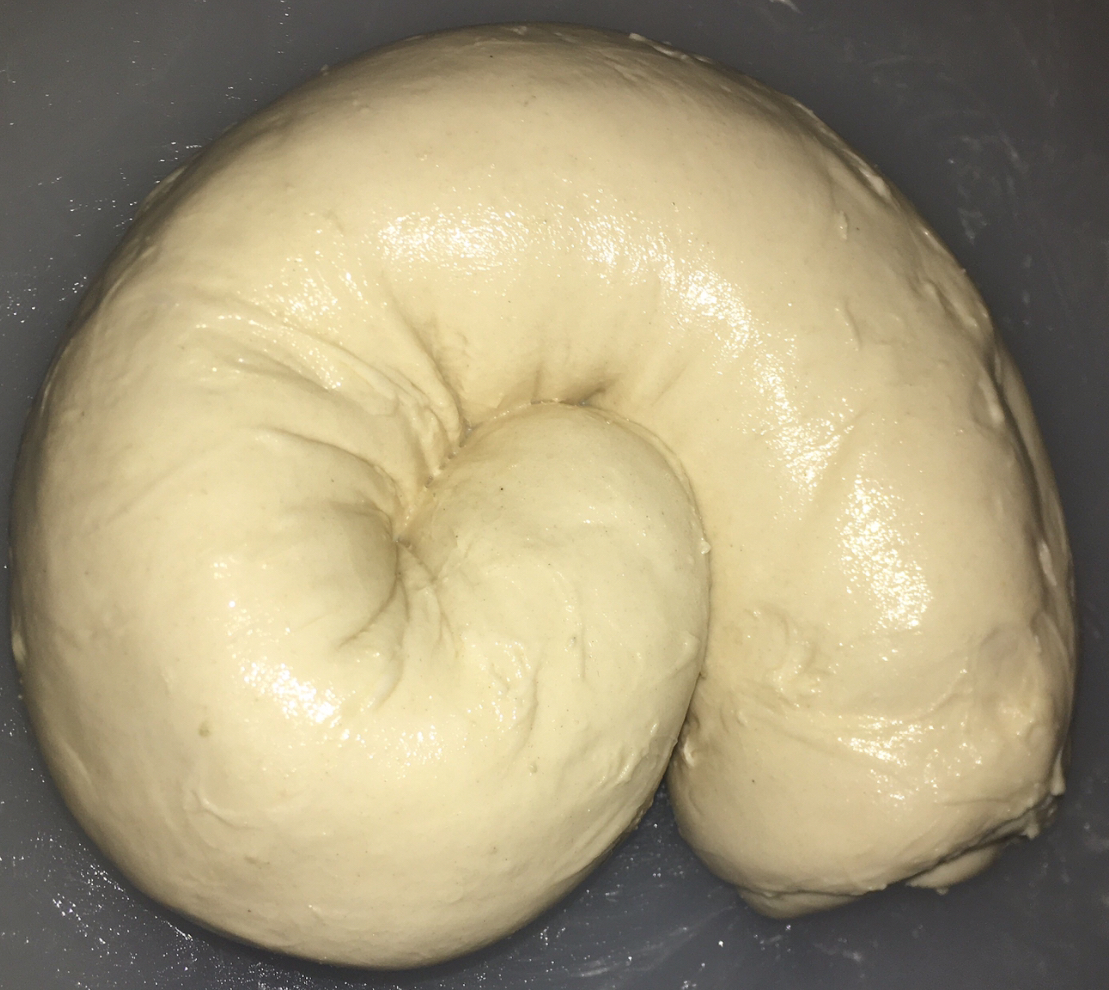|
Laminated Dough
Laminated dough is a culinary preparation consisting of many thin layers of dough separated by butter, produced by repeated folding and rolling. Such doughs may contain more than eighty layers. During baking, water in the butter vaporizes and expands, causing the dough to puff up and separate, while the lipids in the butter essentially fry the dough, resulting in a light, flaky product. Pastries using laminated doughs include: * Croissant pastry *Danish pastry *Flaky pastry *Jachnun *Kouign-amann *Kubaneh *Malawach *Paratha *M'semen *Puff pastry See also * *Dough sheeting, an industrial preparation technique *Filo pastry, used in applications such as baklava, strudel, and spanakopita Spanakopita (; el, ŽāŽĆ╬▒╬Į╬▒╬║ŽīŽĆ╬╣Žä╬▒, from ''span├Īki'' 'spinach', and ŽĆ╬»Žä╬▒ ''p├Łta'' 'pie') is a Greek savory spinach pie. It often also contains cheese, typically feta, and may then be called spanakotiropita ( el, ŽāŽĆ╬▒╬Į╬▒╬║╬┐ŽäŽ ..., where the dough itself is not laminated Ref ... [...More Info...] [...Related Items...] OR: [Wikipedia] [Google] [Baidu] |
Pate Feuilletee 2
Pate, p├ót├®, or pat├® may refer to: Foods P├ót├® 'pastry' * P├ót├®, various French meat forcemeat pies or loaves * P├ót├® ha├»tien or Haitian patty, a meat-filled puff pastry dish * ''Pate'' or ''pat├®'' (anglicized spellings), the Virgin Islands version of empanadas, a meat or vegetable-filled fried-dough dish P├óte 'dough' * ''Pate'', ''p├óte'', or ''paste'', the body of cheese excluding the rind * P├óte ├Ā choux, a kind of choux pastry Places *Pate, Cambodia *Pate Island, also seat of a former Pate Sultanate, in Kenya Other * Pate (instrument), a Samoan percussion instrument * Pate (surname), a surname * P├ót├® (film), a film by Agnieszka Wojtowicz-Vosloo *''Pat─ō'', the M─üori name for the tree ''Schefflera digitata'' * Pate, the surface of the human head, especially a bald head Bald Head () is a bare, ice-free headland on Yatrus Promontory situated southwest of View Point on the south side of Trinity Peninsula on the Antarctic Peninsula in Antarctica. It was prob ... [...More Info...] [...Related Items...] OR: [Wikipedia] [Google] [Baidu] |
Kubaneh
Kubaneh ( he, ūøų╗ų╝ūæųĘų╝ūÉūĀųČūö) is a traditional Yemenite Jewish bread that is popular in Israel. Kubaneh is traditionally baked overnight to be served for Shabbat morning accompanied by haminados (eggs that are baked in their shells along with the bread), and resek agvaniyot (grated tomato). History A Jewish community existed in Yemen for thousands of years, until the 20th century when pogroms, persecution and discrimination forced the Jewish population to flee Yemen en masse, and to seek refuge in Israel. Only a very small community of Jews remains in Yemen today. Yemenite Jews traditionally made their kubaneh from either sorghum flour or cornmeal during the regular weekdays, but used wheat flour on Sabbath days and holidays. Some would add to the dough either sugar, honey or black cumin. Baking was done in a greased pot, tightly sealed, and left to cook overnight. The kub─üneh was eaten the following day while it was still hot, and many of the diners have been known to as ... [...More Info...] [...Related Items...] OR: [Wikipedia] [Google] [Baidu] |
Baking
Baking is a method of preparing food that uses dry heat, typically in an oven, but can also be done in hot ashes, or on hot stones. The most common baked item is bread but many other types of foods can be baked. Heat is gradually transferred "from the surface of cakes, cookies, and pieces of bread to their center. As heat travels through, it transforms batters and doughs into baked goods and more with a firm dry crust and a softer center".p.38 Baking can be combined with grilling to produce a hybrid barbecue variant by using both methods simultaneously, or one after the other. Baking is related to barbecuing because the concept of the masonry oven is similar to that of a smoke pit. Baking has traditionally been performed at home for day-to-day meals and in bakeries and restaurants for local consumption. When production was industrialized, baking was automated by machines in large factories. The art of baking remains a fundamental skill and is important for nutrition, as baked ... [...More Info...] [...Related Items...] OR: [Wikipedia] [Google] [Baidu] |
Spanakopita
Spanakopita (; el, ŽāŽĆ╬▒╬Į╬▒╬║ŽīŽĆ╬╣Žä╬▒, from ''span├Īki'' 'spinach', and ŽĆ╬»Žä╬▒ ''p├Łta'' 'pie') is a Greek savory spinach pie. It often also contains cheese, typically feta, and may then be called spanakotiropita ( el, ŽāŽĆ╬▒╬Į╬▒╬║╬┐ŽäŽģŽüŽīŽĆ╬╣Žä╬▒ "spinach-cheese pie"), especially in northern Greece. In southern Greece, the term spanakopita is also common for the versions with cheese. A version without cheese and eggs is eaten during religious fasts throughout Greece. Ingredients and variations The traditional filling comprises chopped spinach, feta cheese, onions or scallions, egg, and seasoning. Other white, preferably salted cheeses such as kefalotiri may also be mixed with the feta cheese, and some may be used as a substitute for feta cheese. Herbs such as dill, mint and parsley may be used as flavouring. The filling is wrapped or layered in phyllo (filo) pastry with butter or olive oil, either in a large pan from which individual servings are cut, or rolled into ... [...More Info...] [...Related Items...] OR: [Wikipedia] [Google] [Baidu] |
Strudel
A strudel (, ) is a type of layered pastry with a filling that is usually sweet, but savoury fillings are also common. It became popular in the 18th century throughout the Habsburg Empire. Strudel is part of Austrian cuisine but is also common in other Central European cuisines. In Italy it is recognized as a traditional agri-food product (PAT) of South Tyrol. The oldest strudel recipes (a Millirahmstrudel and a turnip strudel) are from 1696, in a handwritten cookbook at the Wienbibliothek im Rathaus (formerly Wiener Stadtbibliothek). The pastry descends from similar Near Eastern pastries (see '' baklava'' and ''Turkish cuisine''). Etymology Strudel is an English loanword from German. The word derives from the German word ''Strudel'', which in Middle High German literally means "whirlpool" or "eddy". Pastry The best-known strudels are apple strudel (Apfelstrudel in German) and Topfenstrudel (with sweet soft quark cheese, in Austrian German Topfen), followed by the Milli ... [...More Info...] [...Related Items...] OR: [Wikipedia] [Google] [Baidu] |
Baklava
Baklava (, or ; ota, ž©ž¦┘é┘ä┘łž¦ ) is a layered pastry dessert made of filo pastry, filled with chopped nuts, and sweetened with syrup or honey. It was one of the most popular sweet pastries of Ottoman cuisine. The pre- Ottoman origin of the dish is unknown, but, in modern times, it is a common dessert of Turkish, Iranian and Arab cuisines, and other countries of the Levant and Maghreb, along with the South Caucasus, Balkans, and Central Asia. Etymology The word ''baklava'' is first attested in English in 1650, a borrowing from ota, ž©ž¦┘é┘䞦┘ł┘ć . The name baklava is used in many languages with minor phonetic and spelling variations. Historian Paul D. Buell argues that the word "baklava" may come from the Mongolian root ' 'to tie, wrap up, pile up' composed with the Turkic verbal ending ''-v''; ba╬│la- itself in Mongolian is a Turkic loanword. Sevan Ni┼¤anyan considers its oldest known forms (pre-1500) to be ''bakla─¤─▒'' and ''bakla─¤u'', and labels it as being of Pro ... [...More Info...] [...Related Items...] OR: [Wikipedia] [Google] [Baidu] |
Filo
Filo or phyllo is a very thin unleavened dough used for making pastries such as baklava and b├Črek in Middle Eastern and Balkan cuisines. Filo-based pastries are made by layering many sheets of filo brushed with oil or butter; the pastry is then baked. Name and etymology The name ''filo'' (phonetic) or ''phyllo'' (transliteration) comes from Greek 'leaf'.Alan Davidson (2014). ''The Oxford Companion to Food'. Oxford: Oxford University Press. . p. 307. In Turkish, it is called ' 'thin', a word which is also used for a kind of thin unleavened bread. In Arabic, it is called ''reqaqot''; in Morocco, warqa ( ar, ┘łž▒┘éž®). The Albanian flia also may be named for ''fije''/''fli'' 'sheet, leaf'. History The origin of the practice of stretching raw dough into paper-thin sheets is unclear, with many cultures claiming credit.Mayer, Caroline E.Phyllo Facts. Washington Post. 1989Archived Some claim it may be derived from the Greeks; Homer's ''Odyssey'', written around 800 BC, mentio ... [...More Info...] [...Related Items...] OR: [Wikipedia] [Google] [Baidu] |
Dough Sheeting
Dough sheeting technology is used by (industrial) bakeries and rolls out dough into a (consistent) dough sheet with a desired even dough thickness. Process Dough is compressed between two or more rotating rollers. When done the right way, a smooth and consistent dough sheet is produced. The dough then passes one or several gauging rollers (mostly on conveyors) that reduce the dough to the required thickness. After this the dough sheet is shaped into a desired dough product. This technology is mainly used in industrial production machines for (semi) industrial bakeries and the food industry. Most dough sheeters can handle a wide variety of dough depending on the machine manufacturer. Most commonly dough sheeting technology is used for the production of laminated dough products like croissants and pastries, but it is also suitable for the production of bread, flatbread and pizza. Function * Shape the dough from individual dough batch to continuous dough sheet * Less damaging of t ... [...More Info...] [...Related Items...] OR: [Wikipedia] [Google] [Baidu] |
Puff Pastry
Puff pastry, also known as ', is a flaky light pastry made from a laminated dough composed of dough (') and butter or other solid fat ('). The butter is put inside the dough (or vice versa), making a ' that is repeatedly folded and rolled out before baking. The gaps that form between the layers left by the fat melting are pushed (leavened) by the water turning into steam during the baking process. History Modern puff pastry, used nowadays in European cuisine was created in France. The oldest recipe of puff pastry in France was written in a charter by bishop Robert of Amiens in 1311. However, the first recipe of the technique of ''tourage'' (the action of putting a piece of butter inside the dough and folding several time the dough) was published in 1651 by Fran├¦ois Pierre La Varenne in ''.'' But it is considered that the invention of this technique was an idea of the famous painter Claude Gell├®e when he was an apprentice baker in 1612. The story goes that Lorrain was making a ... [...More Info...] [...Related Items...] OR: [Wikipedia] [Google] [Baidu] |
M'semen
M'semen, msemmen ( ar, ┘ģž│┘ģ┘å ''msamman'', ''musamman'') or rghaif, is a traditional flatbread originally from the Maghreb, commonly found in Algeria, Morocco, and Tunisia. It is usually served with honey or a cup of aromatic morning mint tea or coffee. M'semen can also be stuffed with meat (khlea) or onion and tomatoes. Varieties and similar foods There is a variety that is made from pulling the dough into strands and forming a disk that is also called ''malwi'' in Northwest Africa. It is also similar to the Somali '' sabaayah.'' Recipe M'semen dough is made of flour, durum wheat semolina, dry yeast, melted butter, salt, sugar and a bit of water. The dough is cut into several balls, which are then rolled out on an oiled surface and folded into square pancakes with multiple internal layers. Semolina is sprinkled on the layers to prevent sticking and to allow for the heat to separate the layers when cooked on a griddle. See also * List of breads * Berber cuisine The Am ... [...More Info...] [...Related Items...] OR: [Wikipedia] [Google] [Baidu] |
Paratha
Paratha () is a flatbread native to South Asia, prevalent throughout the modern-day nations of India, Sri Lanka, Pakistan, Nepal, Bangladesh, Maldives, Afghanistan, Myanmar, Malaysia, Singapore, Mauritius, Fiji, Guyana, Suriname, and Trinidad and Tobago where wheat is the traditional staple. ''Paratha'' is an amalgamation of the words ''parat'' and ''atta'', which literally means layers of cooked dough. Alternative spellings and names include ''parantha'', ''parauntha'', ''prontha'', ''parontay'', ''paronthi'' ( Punjabi), ''porota'' (in Bengali), ''paratha'' (in Odia, Hindi), ''palata'' (; in Myanmar), ''porotha'' (in Assamese), ''forota'' (in Sylheti), ''farata'' (in Mauritius and the Maldives), ''roti canai'', ''prata'' (in Southeast Asia), ''paratha'', ''buss-up shut'', ''oil roti'' (in the Anglophone Caribbean). History The Hindi/Urdu word ''paratha'' is derived from Sanskrit (S. Óż¬Óż░, or Óż¬Óż░ÓżŠ+ÓżĖÓźŹÓżźÓżā, or ÓżĖÓźŹÓżźÓż┐ÓżżÓżā). Recipes for various stuffed whe ... [...More Info...] [...Related Items...] OR: [Wikipedia] [Google] [Baidu] |
Malawach
Malawach or MelawwaßĖź, (; literally means "board-like bread"), is a flatbread that is traditional in Yemenite Jewish cuisine. It was brought to Israel by Yemenite Jews. Malawach resembles a thick pancake but consists of thin layers of puff pastry brushed with oil or fat and cooked flat in a frying pan. It is traditionally served with hard-boiled eggs, ''zhug'', and a crushed or grated tomato dip. Sometimes it is served with honey. History Malawach is made from the same dough as jachnun, a Yemenite Jewish Shabbat bread, and both originated as a variation of hojaldre, a Sephardic Jewish puff pastry, brought to Yemen by Jews expelled from Spain. Hojaldre later became ''"ajin"'', an enriched dough only made by the Yemenite Jews, and was not made by the non-Jewish Yemenis, according to Rabbi Gil Marks, a Jewish food historian Preparation Malawach was traditionally prepared at home by the women in the Yemenite Jewish community, and is made out of a laminated dough similar to ... [...More Info...] [...Related Items...] OR: [Wikipedia] [Google] [Baidu] |






